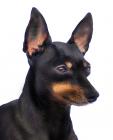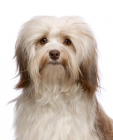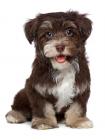Havanese

In my own words
So much personality packed into one small, sturdy Cuban dog. My cousin’s include the Bichon, who like me were bred solely for human companionship and a lap dog type. We come from Havana, Cuba and were created sometime in the late 1800’s to early 1900’s for the elite and the rich people’s needs. Due to this trait I crave attention almost all the time, and will do my very best to charm and entertain my loved ones in order to get a reaction. As long as I have my family that loves me and to call my own I will be a happy little dog. One tip is don’t let me develop small dog syndrome as I know I can come across sweet, pampered, baby doll like, but really I’m just a dog like any other and need exercise, leadership, obedience and then some affection.
My ideal owner(s)
Elderly
Work from home types
Families
What they say about me
Friendly
Outgoing
Intelligent
Lively
Affectionate
Is this Havanese for you?
Test your knowledge about the Havanese
Information essential about the Havanese
Breed Group – Toy Group
SIZE
Male: Height: 8.5 – 11.5 inches, Weight: 7 - 13 pounds
Female: Height: 8.5 – 11.5 inches, Weight: 7 - 13 pounds
Popularity:
The Havanese's popularity in the show ring has grown quickly, and they are also now high in demand as a family pet. Their popularity as pets waned, however, and their stronghold remained in the circus, where they performed throughout Europe as trick dogs. Eventually the breed declined in numbers to such an extent that it was almost extinct not only in Europe but also in its native Cuba. A few remained in Cuba, however, and three families with their Havanese left Cuba for the United States during the 1950s and 1960s. Most present-day Havanese descends from these dogs. The breed has gradually aroused attention from dog fanciers and pet owners, and in 1996 the first Havanese entered an AKC show ring and was accepted for regular recognition as a member of the toy group as of the first day of 1999. After the Cuban revolution in 1959, the breed fell on hard times. A few came to the United States with Cuban refugees, and in 1979 the Havanese Club of America was formed. It has grown from nine members to approximately 400 members, and the Havanese was admitted to the American Kennel Club’s Toy Group in 1999. Since then, his popularity has exploded because of his great charm. Currently, he ranks 31st among the breeds registered by the American Kennel Club, up from 43rd in 2005 and 86th in 2000.
Breed History:
An old breed, we are talking ancient, the Havanese is a descendent of breeds brought to Cuba from Spain and could also be related to the Tenerife, an ancestor of the entire Bichon family. The National Dog of Cuba and the country's only native breed. Once known as the Havana Silk Dog and the Spanish Silk Poodle, the Havanese evolved from its role as a pampered lap dog of the aristocracy into a family companion responsible for being a watchdog, child's playmate and herder of the family's poultry flock. This little dog is the Cuban member of the Bichon family, a group that includes Bichon Frise, Bolognese, Coton de Tulear, Lowchen and Maltese. These breeds differ in coat type and character. They are thought to have originated in the Mediterranean area. Bichon type dogs were probably taken to Cuba by traders & settlers and to have evolved into the Havanese.
Character:
Happy with a zest for life, they adore their family, bonding closely with them.
This is the main reason why Havanese are not suitable as kennel dogs. Their
greatest desire is to live at home as part of the family. They will become sad &
introverted if left alone regularly or repeatedly for the greater part of the day
& so are not suitable for people who work full time. Havanese need companionship
to thrive. They are very good with children, especially older children who can
appreciate their small size & play with them appropriately. They love their toys
& can be very entertaining involving their humans in games of their own devising.
Havanese mix well with other breeds. They enjoy obedience training & mini agility
or indeed any pastime in which they can participate & be with their owner. They
want to please while still maintaining their own individual character. They are
easy to house train as they are very clean by nature. They don't mind water &
indeed have been known to swim! They will give warning but are not "yappy"
Temperament:
The Havanese is a bright and lively little dog that likes to think up his own games and then play them with you. It's certainly possible to spoil a Havanese, but they're pretty resistant to becoming tyrants and generally respond well to a little judicious indulgence. This is a busy, curious dog; it is happiest when it is the center of attention. It loves to play and clown and is affectionate with its family, children, strangers, other dogs and pets — basically everyone! The Havanese is willing to please and learn easily, but it tends to be vocal. The Havanese has a classically winning temperament, always willing to please and quick witted. He is easy to train, and has an aptitude for performing in obedience competitions. The breed’s history of circus tricks aids him in agility.
Havanese attaches strongly to their families, as they should: their job was always to be a companion. Its true to say life with a Havanese is a special treat. Expect to find yourself accompanied at all times by a funny, friendly, smart best friend who adapts to your lifestyle and schedule. Often mischievous, occasionally naughty — shredding paper is a favorite pastime — the little dogs from Cuba will fly across your furniture, take over the couch and bed, alert you to visitors or intruders, and interpret and adjust to your every mood.
The Havanese has a sense of humor and loves the attention he gets when he does funny things. He is a clown and performs all the time. He’s cute and fun, but he’s not perfect. Any dog, no matter how nice, can develop obnoxious levels of barking, digging and other undesirable behaviors if he is bored, untrained or unsupervised. And like many toy breeds, especially those in the Bichon family, Havanese aren’t always easy to housetrain, but consistency and strict supervision will win the day. Avoid giving them too much freedom to roam the house too soon. Many report their dog's favorite spot to be a perch where they can look out the window and announce what is happening outside. Early training is important so that your Havanese obeys commands to cease barking. Separation Anxiety is another common problem with Havanese. They are companion dogs that are highly dependent upon the people they love. People who are not home very often would be doing this breed a disservice. They are best suited for retirees or families with a stay at home parent
Conformation:
The Havanese is a small, sturdy dog of immense charm. The native dog of Cuba, he is beloved as a friendly, intelligent and playful companion. The Havanese is a small, sturdy dog with a friendly disposition. His wavy, silky coat is profuse, but remains extremely light, insulating and protecting the breed against harsh tropical heat. His coat, which comes in all colors, should remain untrimmed. The unique springy gait is a result of the breed's structure and playful, spirited personality. These characteristics of temperament, coat, structure and gait are essential to type. Thanks to his cheerful and loving temperament, he's wonderful with children and is good at obedience and agility. The Havanese makes a terrific therapy dog because of his easy temperament, not to mention he fits onto any size lap. The Toy breeds are small companion or lap dogs. Many of the Toy breeds were bred for this capacity although some have been placed into this category simply due to their size. They should have friendly personalities and love attention. They do not need a large amount of exercise and some can be finicky eaters. A wonderfully happy breed, the Havanese has a unique gait, referred to as springy, that announces his cheerful temperament. He springs along and makes you laugh. He’s easygoing, easy to train, and quick-witted. Between his sturdiness, his willingness to please, and his spinning and jumping habits, it’s no wonder that he excels at tricks and was a circus dog. Watching Havanese play is a giggle. They like to tear around the house or yard and will play for hours with anyone who has the patience and stamina to keep up with them. Even though they’re small in stature, they’re very sturdy and agile. They are also happy to settle on a lap — anything is fine with a Havanese as long as it involves attention.
Colour:
Cream, gold, sables, tobacco brown, silver, to black and any combination of these colours.
Training:
Start training your Havanese puppy the day you bring him home. Even at 10 to 12 weeks old, he is capable of soaking up everything you can teach him. Never wait until he is six months old to begin training, or you will have a more headstrong dog to deal with. If possible, get him into puppy kindergarten class by the time he is 10 to 12 weeks old, and socialize, socialize, socialize. They will do anything for attention, and when training is conducted with positive reinforcement and treats, a Havanese catches on quickly. Harsh discipline will get you nowhere – a Havanese will shut down completely if his trainer yells or pulls.
Care:
Although energetic, the Havanese can have its exercise needs met with a short walk or a good play session. It is not a dog that can live outside. Coat care entails brushing two to four times a week. This is a no shedding dog, which means that loose hairs are caught in the outer hairs, tending to tangle, unless they are combed out.
The breed's non-shedding coat makes it suitable for allergy sufferers, but regular grooming is necessary to keep the coat in top condition.
Health:
All dogs have the potential to develop genetic health problems, just as all people have the potential to inherit a particular disease. The Havanese has the potential to develop a number of health problems. They include Legg-Calve-Perthes disease, luxating patellas, various eye problems, deafness, hypothyroidism, and heart problems. Legg-Calve-Perthes Disease affects a wide range of small breeds, including Havanese. The blood supply to the head of the femur (the ball in the ball and socket joint of the hip) is inadequate, which causes the head of the femur to degrade. Patellar luxation happens when the kneecap pops out of normal position. It can range in severity from mild
The Havanese is a long-lived healthy breed with an average life expectancy of 14 to 15 years.
You may also like:
If you like Havaneses, you may be interested in breeds of the same size »





If you like Havaneses, you may like other breeds with similar characteristics »





If you like Havaneses, you may be interested in these other toy dogs »





Advice on choosing your breed »
Find an animal shelter or rescue home where a Havanese is waiting for a new home »
The biggest problem with this breed, with its adorable nature and it's appealing face,
mannerisms & personality can within a very short time lead to it being spoiled. It is tempting
to carry them about constantly, to baby them-DON'T. Allow them to run, play,
have a daily walk, be a dog. Even if most of the time, they don't think they are!
Havanese are a rare breed not just in the U.K. but worldwide so you may have to
wait until a puppy is available. The Havanese Dog Breed has a personality and
temperament that is intelligent and sensitive. They crave attention and bond
closely with their human companions. Make sure you can be around for them as they
cannot handle being left alone for too long. While the Havanese is a watchful dog,
this little breed welcomes friends and strangers alike into the home and barks very little
so can easily live an adapt to an apartment setting with children or with elderly people.
Be the first to rate this breed »
|
*PLEASE NOTE: All our breed profiles are general, and all dogs are individuals. Always talk to the breeders and meet the owners you are buying from. Try to meet the dog and its parents if it is a puppy in their home environment.












